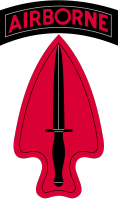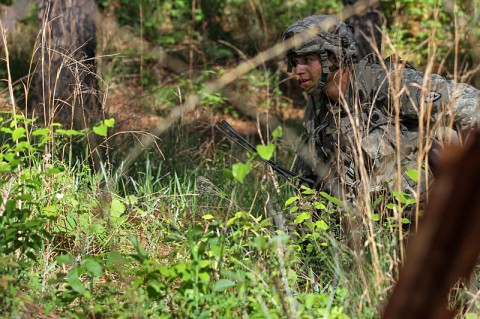Written by Staff Sgt. Christopher Klutts
20th Public Affairs Detachment
 Fort Polk, LA – An American man has a heart attack on the third floor of a hotel that doubles as an evacuee holding area. Protestors chant for change outside a U.S. consulate. A small village is struck with measles and enemy artillery rocks a city – all of this happens between lunch and dinner.
Fort Polk, LA – An American man has a heart attack on the third floor of a hotel that doubles as an evacuee holding area. Protestors chant for change outside a U.S. consulate. A small village is struck with measles and enemy artillery rocks a city – all of this happens between lunch and dinner.
By design, training scenarios are complex at the Joint Readiness Training Center in Fort Polk, LA. Hundreds of role-players assume fake identities and mill around a mock foreign country. Its landscape is dotted with towns and villages, the names of which change based on the real-world region a unit might operate in.

In April, a task force of more than 4,000 Soldiers, predominantly comprised of paratroopers with 4th Infantry Brigade Combat Team (Airborne), 25th Infantry Division, and Green Berets with 5th Special Forces Group (Airborne), trained together in the new decisive action training environment at JRTC.
The decisive action training environment tests a brigade’s ability to conduct large-scale, offensive and defensive operations against a near-peer enemy, support an embattled host nation government and fight an insurgency – sometimes simultaneously.
“The Joint Readiness Training Center really offers a complex environment for the rotational unit that they really can’t duplicate or replicate at home station,” said U.S. Army Col. Randall L. Harris, deputy commander of Operations Group at JRTC.
The scenario starts with security deteriorating in an allied country. Insurgents attack the host nation government while enemy armor and infantry units prepare to advance. The ally country calls for help, and U.S. forces answer.
During the exercise in April, Green Berets with 5th SFG (A) used unconventional warfare tactics to disrupt enemy activity that set conditions for thousands of Soldiers with 4-25 IBCT (A) to assault into the training area.
Leaders with 4-25 IBCT (A), garrisoned at Fort Richardson, Alaska, and 5th SFG (A), out of Fort Campbell, KY, started planning together before either left home. Once they arrived to the intermediate staging base in Alexandria, VA, they shared intelligence about the impending operation.
“We’ve worked hard with Special Operations Command and with the Special Operations Detachment at the Joint Readiness Training Center,” said Harris. “During the scenario, there are events that take place that have to have interdependence, or they will fail.”
The consulate, staffed by role-players with varying levels of real-world diplomatic experience, provides an in-depth assessment of the host nation’s political and structural situation, said U.S. Army Lt. Col. Michael King, director of interagency training at JRTC.
“The special operations guys don’t have the ability to directly influence that. But they can work with their brigade counterparts, who do have more significant forces and resources that they can bring to solve that problem,” King said.
Soldiers with 4-25 IBCT (A) entered the notional country and worked with 5th SFG (A) and civilian role-players representing U.S. government agencies to evacuate noncombatants.
“The interagency play here at the Joint Readiness Training Center is an aspect that units really don’t have an opportunity to train at home station, primarily because of the depth the interagency provides,” said Harris.
Unlike mission rehearsal exercises that prepared units for counterinsurgency operations, the decisive action environment pits units against an enemy with capabilities similar to the U.S. military.
“With the decisive action rotation, really I think it boils down to getting back to core competencies. You name the war fighting function,” he said.
Soldiers with 4-25 IBCT (A) prepared to defend their ally against armor, infantry and air attacks brought by the resident opposing force at JRTC, Geronimo Soldiers with 1st Battalion, 509th Infantry Regiment (Airborne).
“Basically, I’m the senior bad guy. I get a task and purpose to win just like the brigade does,” said Lt. Col. Matthew Tackett, commander of 1st Bn., 509th Inf. Reg. (A). “My job is to do everything I can to desynchronize their fight, harass them, and push them as close as we can to failure.”
Tackett said a brigade combat team must use all of its assets to win against a multifaceted enemy. His opposing forces attack the brigade on every front. They raid fighting positions in the swamps, attack villages with tanks and even hack the brigade’s computers.
In the decisive action training environment, brigade combat teams enter a sovereign country that asked for U.S. help. They train to be the first on the ground.
“The expeditionary mindset is more than a philosophy, it’s actions,” Harris said. “What they come in with is what they have until they continue to build combat power.”
Whether at the National Training Center in Fort Irwin, CA, the Joint Multinational Readiness Center in Hohenfels, Germany, or at JRTC, units prepare extensively before entering what is known in all three locations as “The Box.”
The Box is where the test begins. Thousands of Soldiers work together toward hundreds of goals, during dozens of missions as part of one training exercise. But, The Box provides uncertainty, simulates the fog of war and always has its say in how a unit will fare – as does combat.
“All these things put you in a real environment where there are consequences based on your actions, both good and negative,” Harris said. “Just having the brigade step off and really put their unit in the field for the first time is pretty awesome to see.”


